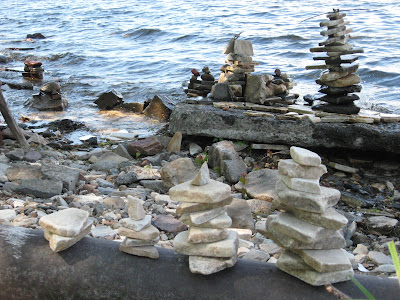
I'd never made filled
bing before, but everyone in the family is quite fond of
green onion pancakes, which are made with the same hot water dough, so when I saw my TV chef idol
Ming Tsai's episode featuring several different kinds of bing, I figured I should try it out. Then on Monday we got a nice bunch of beets with greens still attached from the CSA farm, and inspiration struck to serve the bing with greens and a sauce on top (rather than the more traditional dipping sauce).
If you want to be most efficient on time, cook, peel and chop the beets ahead of time, then proceed in this order about 45 minutes to an hour before you want to eat: soak dried shiitake (unless using fresh), make dough, make filling, prep sauce ingredients, make bing, fry bing & make pan sauce.
Hot Water Dough2 cups flour, plus additional as needed
1/2 tsp salt
1 cup boiling water
1 1/2 TBSP canola oil
Combine water and salt in a mixing bowl, then pour in boiling water and oil and mix with a wooden spoon until the dough comes together. Knead for about five minutes or so, adding flour as necessary to keep dough from sticking to the counter, until smooth (it won't get as smooth and elastic as bread dough). Form into ball and allow to rest for at least 20 minutes.
Filling4-5 scallions, white and light green parts, chopped
1 tsp minced ginger
1 bunch of beets (4-5 small to medium), greens reserved, roots boiled until tender, peeled, and chopped
8-10 shiitake mushrooms, fresh (or dried and soaked in hot water for 20 minutes), sliced
a little canola oil
dash of soy sauce
freshly ground black pepper
Heat the oil in a small frypan and sauté the scallions and ginger for a minute or two, then add shiitake and cook for a few minutes if dried; until well browned and liquid evaporates from pan if fresh. Add beets, a splash of soy sauce and a good grind of black pepper, mix everything together well, and remove from heat. Let cool.
Forming and Cooking the Bing1. Divide the dough into 8 balls, and roll each ball out into a 6-8 inch disk, about 1/8" thick in the center and thinner on the edges.
2. Place about 1/2 cup of filling in each disk, then pull up the edges around the filling and twist to seal. If it's sticky, dust top and bottom with a little additional flour.
3. Once bing are formed, heat a generous amount of oil in a heavy skillet (I used cast-iron) with a lid. Put the bing, sealed side down, in the oil, then flip when bottom is crisp and golden-brown.
4. When both sides of the bing are crisp, with lid at the ready, pour 1/3 cup water into the skillet and cover
IMMEDIATELY (otherwise you will have splattering all over). Cook until you can hear the water has boiled off, 2-4 minutes.
5. Once the water has boiled off, remove the lid and cook the bing for several minutes on each side, until crisped up again. Remove to a paper-towel-lined plate.
6. Unless you have a really large skillet (or are making a half-recipe), you'll have to do this in two batches, which is OK, because the bings hold their heat quite well.
Greens and Pan Sauce1 small onion, minced
1 TBSP minced ginger
reserved greens from one bunch of beets, washed and coarsely chopped
zest and juice of 1 orange
splash of white wine or vermouth
salt to taste
1 TBSP cold butter
1. When you're finished cooking the bing, pour off all but a slight film of oil from the skillet. Add the onions and cook, stirring, until starting to brown.
2. Add the ginger and orange zest and cook for 1-2 minutes more.
3. Add the beet greens and a pinch of salt, and cook until the greens are wilted and reduce.
4. Add a splash of white wine or vermouth, and cook until almost all liquid has evaporated.
5. Add the orange juice and reduce by half.
6. Take the pan off the heat, add the cold butter, and swirl to emulsify. Pour sauce over the bings and serve.
The filling:

The bing:

Frying the bing:













